City of Birmingham Tramways
History
The City of Birmingham Tramways Company (CofBTCo) began life on the 29th September 1896, when it was registered by the Scottish-Canadian railway and tramway pioneer James Ross. Ross's intention was to electrify all the tramway lines worked by the Birmingham Central Tramways Company, the majority of which were leased from Birmingham Corporation. With the exception of two lines that penetrated into Birmingham from Aston Manor (operated by the Birmingham and Aston Tramways Company) and Dudley (Birmingham and Midland Tramways Limited), the BCTCo had effectively made itself master of the tramways within and immediately surrounding Birmingham. Unfortunately, this had been achieved by buying up all its competitors (and/or their tramway powers) and entering into leases with Birmingham Corporation under somewhat onerous terms. The money raised to fund this spending spree meant that the company was badly over-capitalised, and no matter how hard it tried, it was never going to give the shareholders a return on their investment. The situation was exacerbated by the company's use of four different modes of traction (horse, steam, cable and battery-electric), which can hardly be described as efficient.
At some point (it is unclear when), the trials and tribulations of the BCTCo attracted the attention of James Ross (and his partner, William Mackenzie), who subsequently bought it out, the CofBTCo seemingly taking over all the BCTCo's assets on the day the company was registered. This presumably allowed Ross to carry out a restructuring, in order to finance the hoped-for electrification, Unfortunately for the CofBTCo, its grand plans to convert the entire network to overhead electric working, including the building of new lines, were to be thwarted by Birmingham Corporation's insistence that all lines within its environs should be worked using conduit current collection. Although preferred by many local authorities on aesthetic grounds, conduit tramways were alarmingly expensive to construct, and for this reason were only built when local authorities made it clear that no other alternative would be considered. As a result of its failure to reach agreement with the corporation, all lines within the city were deleted from the company's City of Birmingham Tramways Act, 1897, which received Royal Assent on the 6th August that year. Despite this, negotiations with the corporation continued, though they were finally broken off on the 7th June 1898, the company presumably baulking at the rental that they would have been required to pay.
The following year, the corporation decided to seek powers to operate its lines as and when the various leases expired, these being granted on the 11th August 1903 under the Birmingham Corporation Act. Meanwhile, and despite seeking its own powers, the corporation agreed that the company could convert the Bristol Road route from battery-electric to overhead electric working, the first services using the new form of traction commencing on the 14th May 1901. The CofBTCo therefore became unique amongst tramway systems within the British Isles in operating horse, steam, cable and overhead electric services simultaneously.
By June 1902, however, the CofBTCo had sold out to the British Electric Traction Company, which was in the midst of building a large overhead electric tramway network spanning Birmingham and the Black Country. The BETCo doubtless thought that it could persuade the corporation to rethink its plans to operate its own system, the corporation having yet to acquire the powers, though in this it was ultimately to be disappointed. The BETCo was, however, more successful with neighbouring Aston Manor, reaching agreement on the 9th June 1903 to take over operation of the borough's tramway on a 21-year lease; the CofBTCo took over the existing steam services on the 1st January 1904, the first overhead electric services within the borough running on the 19th September 1904. This was followed by further conversions of the lines it owned outside Birmingham.
Unfortunately, and despite the BETCo's best efforts, and a heated debate within Birmingham Corporation on the merits of municipal versus company operation, the corporation proceeded with conversion of its lines (as the leases expired), introducing its first electric service — between Steelhouse Lane and the Aston Manor borough boundary — on the 4th July 1904, ironically, using overhead electric current collection. Although the irony was probably not lost on the CofBTCo, and despite looming lease expiries, the company seems to have maintained a good relationship with the corporation, the latter allowing company-operated through services into Birmingham.
Meanwhile, on the 4th December 1903, it was agreed that all the BETCo's Black Country and Birmingham-area tramway interests would be merged into Birmingham & Midland Tramways Limited. From the 1st July 1904, all these systems (operated by Birmingham and Midland Tramways Limited; the City of Birmingham Tramways Company; the Dudley, Stourbridge and District Electric Traction Company; the South Staffordshire Tramways [Lessee] Company; and Wolverhampton District Electric Tramways Limited) were managed as a single entity by the Birmingham and Midland Tramways Joint Committee (B&MTJC). The merger resulted in economies of scale across the enterprise, perhaps most notably in the introduction of a very successful Tramways Parcels Express Service (begun in 1905), and the setting up of a major tramcar building and maintenance facility at Tividale, between Dudley and Oldbury.
Further powers to reconstruct and expand the city's tramway system were acquired by the corporation in 1905. As a result, the CofBTCo ran its last horse-drawn service (between Albert Street and Nechells) on the 30th September 1906, and its last steam service on the 31st December 1906 (along Stratford Road), the majority of its leases expiring at the end of the day. As conversion of the corporation-owned lines proceeded, prior to expiry of the leases, the company sold the corporation its infrastructure (e.g. tramway depots) within Birmingham, as well as lines that had previously lain outside the city prior to municipal expansion in 1891; it also sold its lines in Moseley and Kings Heath to Kings Norton and Northfield Urban District Council — as they were effectively physically isolated — the authority in turn leasing their operation to Birmingham Corporation.
The CofBTCo's last cable service ran on the 30th June 1911 (on the Handsworth route), the leases of the last company-operated lines within Birmingham expiring that day. Although this ostensibly left the company in possession of its lines outside the Birmingham municipal boundary, the corporation had in fact reached agreement with the company to buy all its remaining assets, including taking over its remaining leases (outside Birmingham). The main driver for this was the coming expansion of the municipal boundary, which would encompass the neighbouring authorities of Aston Manor, Erdington, Handsworth, Kings Norton and Northfield, and Yardley. Although the sale had been agreed on the 25th July, with the expansion duly taking place on the 9th November, the deal with the CofBTCo could only be ratified by the expanded council, this not taking place until the 28th November 1911. Meanwhile, the CofBTCo continued to operate its services, Birmingham taking over on the first day of 1912, with the CofBTCo running its last tram on the day before.
At its zenith, the CofBTCo operated circa 36.65 miles of 3ft 6ins-gauge tramway, the vast majority of it leased from Birmingham Corporation. The system comprised lines: northwards to Perry Barr and Witton; northeastwards to Gravelly Hill, Nechells, and Saltley; eastwards to Yardley; southeastwards to Spark Hill; southwards to Kings Heath; southwestwards to Bournbrook; and northwestwards to Handsworth and Lozells.
The CofBTCo entered liquidation on the 31st May 1912.
Uniforms
Although photographs of staff working the horse-tram services are relatively rare, it is clear that drivers wore informal yet smart attire, comprising trousers, jackets and waistcoats, along with white shirts, ties, and bowler hats. Conductors appear to have worn informal jackets, along with drooping-peak caps, which almost certainly bore a one-piece 'CBT' block-capitals cap badge. Some time in the early-Edwardian era, very probably following the BETCo takeover of 1902, a switch was made to single-breasted jackets with five buttons, one pocket on the bearer's left-hand breast (with a button closure and a pleat) and stand-up collars; the latter probably bore individual 'C B T' initials on the right-hand side, and an employee number on the left-hand side, all in brass. All surviving photographs dating from late in the tramway's life show horse-tram conductors wearing flat caps, so the pre-BETCo drooping-peak caps were presumably dispensed with at some point prior to the last horse-tram running in 1906.
In common with the majority of UK steam-operated tramways, steam-tram drivers wore very similar attire to their railway counterparts, namely, heavy cotton trousers and jackets, often light in colour, along with cotton or flat caps. No badges or insignia were worn on either the jackets or the caps. Conductors on the other hand appear to have worn a variety of smart jackets, suggesting that they were self-purchased rather than company issued. Like their horse-tram counterparts, steam-tram conductors wore drooping-peak caps bearing a one-piece 'CBT' block-capitals cap badge. In later years, again probably following the BETCo take-over of 1902, conductors were issued with single-breasted jackets with a single breast pocket (with button closure and pleat) and stand-up collars; the latter bearing the same insignia as horsecar conductors' jackets. Although steam-tram conductors initially wore flat caps, they were eventually provided with tensioned-crown peaked caps; these almost certainly bore a script-lettering grade badge, presumably 'Conductor'.
Drivers and conductors working the cable-hauled services appear to have initially worn very similar attire to their steam and horse counterparts, i.e., informal but smart jackets, along with company-issued drooping-peak caps bearing one-piece 'CBT' cap badges. It is highly likely that crews working these services were eventually issued (circa 1902) with the same style of uniforms as those issued to conductors working the steam and horse services, namely, single-breasted jackets with stand-up collars. Following the creation of the B&MTJC in 1904, tramwaymen working the cable services were eventually issued with the same style of uniform as those working the electric services (see below).
Tramcar crews working the CofBTCo's new electric services (introduced on the 14th May 1901) were provided with uniforms, though what insignia they bore, if any, is unclear. After the BETCo take-over of 1902, motormen and conductors working on the electric cars were issued with the same style of single-breasted jacket, with five buttons, a single breast pocket and stand-up collars, that were issued to their horse and steam counterparts. The caps were, however, of the tensioned-crown peaked type, which appear to have carried a standard, off-the-shelf, script-lettering grade badges. Several photographs show staff wearing flat caps, suggesting that it took some time to issue proper uniform caps.
Following the creation of the B&MTJC on the 1st July 1904, a standard uniform policy was eventually imposed across all the member companies, including the CofBTCo. Motormen and conductors were now issued with double-breasted jackets with four pairs of buttons (bearing the standard BETCo 'Magnet and Wheel' device — see link) and high, fold-over collars; the latter carried individual metal initials — either 'B M T' or 'B & M T' — on the right-hand side and an employee number on the left-hand side, all almost certainly in brass. Surviving examples suggest that the first collar badges may have had diagonal striations giving a rope-like effect (see below). The employee number was eventually dispensed with, leaving the left-hand collar badgeless. Caps were initially of the drooping-peak type; they carried a prominent oval brass cap badge comprising intertwined 'BMT' initials beneath the 'Magnet and Wheel' device, all within a wreath (see below). The new uniform was certainly worn on the company's cable and electric services, but seems not to have been extended to staff working the horse and steam services (both withdrawn in 1906), possibly because its introduction post-dated their demise.
Conductors and drivers working within the confines of Birmingham during the horse, steam and cable eras were required to wear a round licence badge; these bore the arms of Birmingham, a number and the grade ('CONDUCTOR'). For some reason, this requirement seems not to have been applied to steam engine drivers, though they may have had them but simply didn't bother to wear them. In the electric era, conductors and motormen working within the Birmingham boundary were also required to wear licence badges, still with the arms, a number and the grade, but in a new style (see below).
Photographs of inspectors taken prior to the BETCo take-over of 1902 are unfortunately scarce, however, what has survived suggests that they wore single-breasted jackets with lapels, along with soft-topped caps. Details of the insignia remain unknown. During the period following the creation of the B&MTJC, inspectors wore typical tramway-inspector jackets, single-breasted with hidden buttons (or more likely hook and eye fasteners), edged in a finer material than the main jacket, and with stand-up collars; the latter carried the grade — 'Inspector' — in embroidered script lettering, as did the drooping-peak caps. The caps also bore the same pattern of BMT cap badge worn by tramcar crews.
Further reading
For a general history of the tramways of Birmingham, including the CofBTCo, see: 'Birmingham Transport — a History of Public Road Transport in the Birmingham Area' by A G Jensen; Birmingham Transport Historical Group (1978).
Images
Horse tram drivers and conductors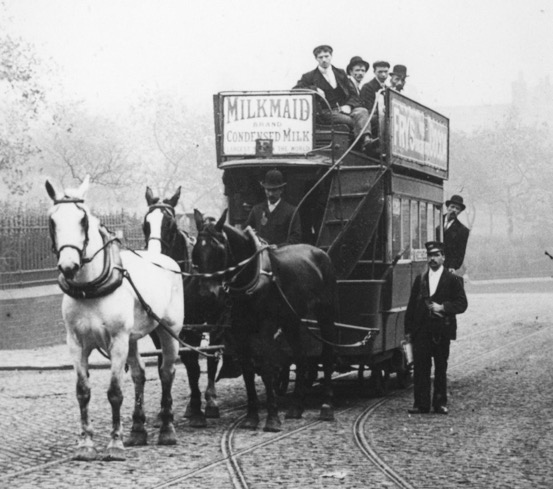
A Nechells horse tram arriving at the foot of Albert Street — photo undated, but probably taken in the early Edwardian era. Author's Collection.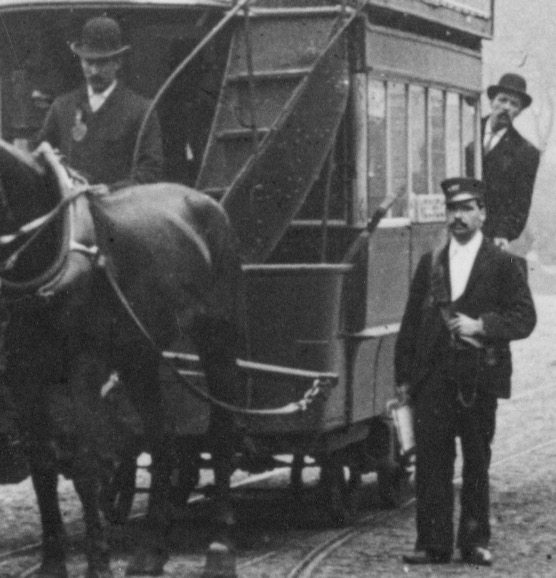
An enlargement of the above photograph showing the driver and the conductor; the former is clearly wearing a licence badge, whereas the situation with the latter is less clear. The conductor's drooping-peak cap bears a badge of some description, almost certainly 'CBT' block capitals (see below); his jacket would appear to be informal.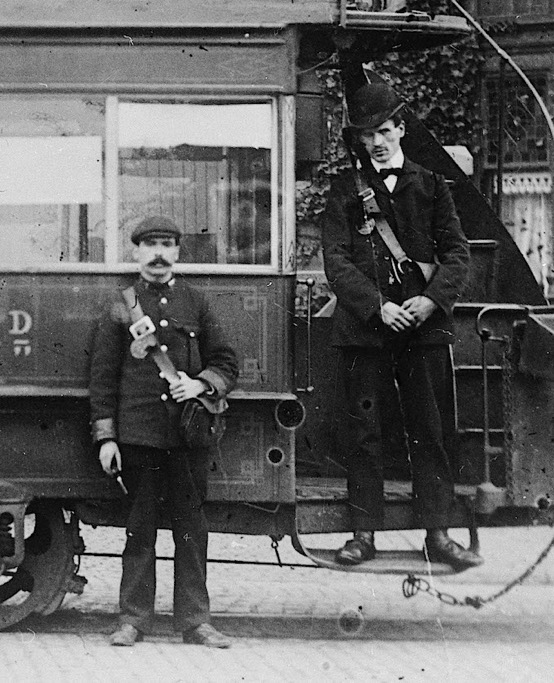
Horsecar No 7 on the Nechells Road route in 1906. By this time conductors were clearly being provided with single-breasted uniform jackets, though seemingly without formal caps. Photo purportedly by A Twigg, courtesy of the National Tramway Museum.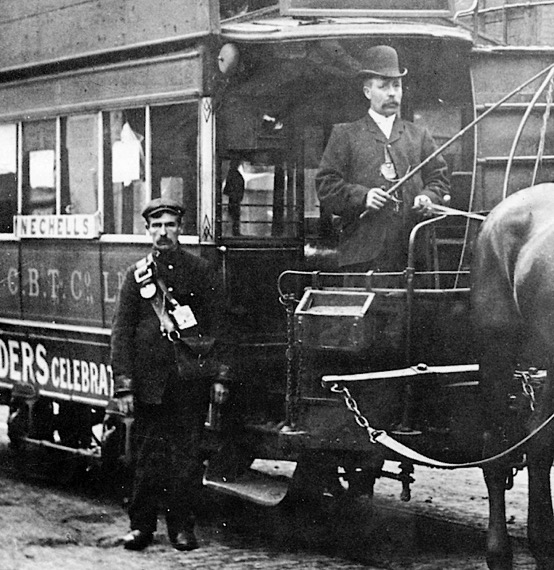
The conductor and driver of the last Birmingham horse tram (No 2), on the Nechells Road route — photo taken on 30th September 1906, the last day of horse-tram operation. The crew are thought to be Driver G Little, and Conductor A (?) Gallimore. Both men are wearing round licence badges, probably of the type depicted below. Photo by A Twigg, courtesy of the Tramways and Light Railway Society.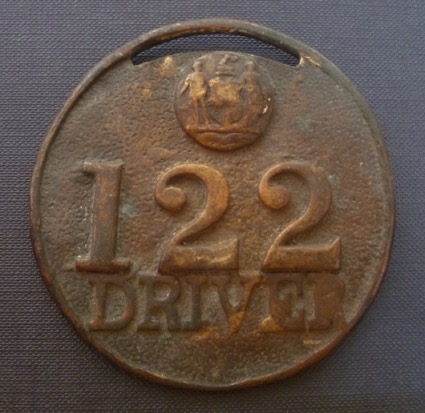
Birmingham municipal 'DRIVER' licence badge (No 122), almost certainly the same pattern issued to drivers working the City of Birmingham Tramways Company's horse, cable and electric services from 1896 (following the full grant of arms to the new city in 1889) to the early Edwardian era. Author's Collection.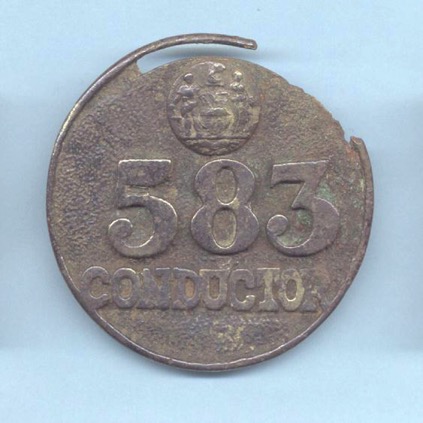
Birmingham municipal 'CONDUCTOR' licence badge — almost certainly the same pattern issued to conductors working the City of Birmingham Tramways Company's horse, steam, cable and electric services from 1896 (following the full grant of arms to the new city in 1889) to the early Edwardian era. 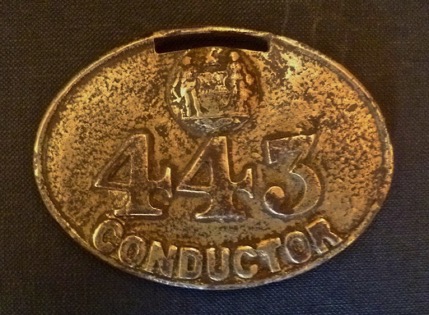
Birmingham municipal licence — brass. This oval pattern of licence may well have been used at some point, though photographic evidence supporting this is completely lacking. Author's Collection.
Steam tram drivers and conductors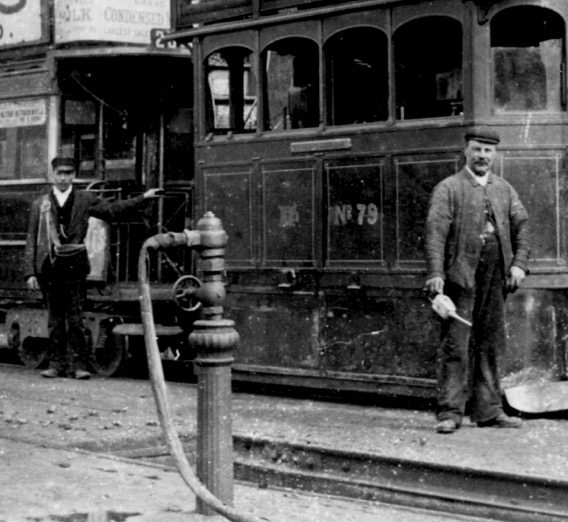
A conductor and a driver with Kitson Steam Tram No 79 and Falcon Trailer No 23 (possibly) in the depot yard at Kings Heath — photo undated, but probably taken in the late 1890s or early 1900s given that No 79 was new in 1893 and it is looking distinctly the worse for wear here. The only uniform item on show appears to be the conductor's drooping-peak cap. Photo courtesy of the Tramways and Light Railway Society, with thanks to David Voice.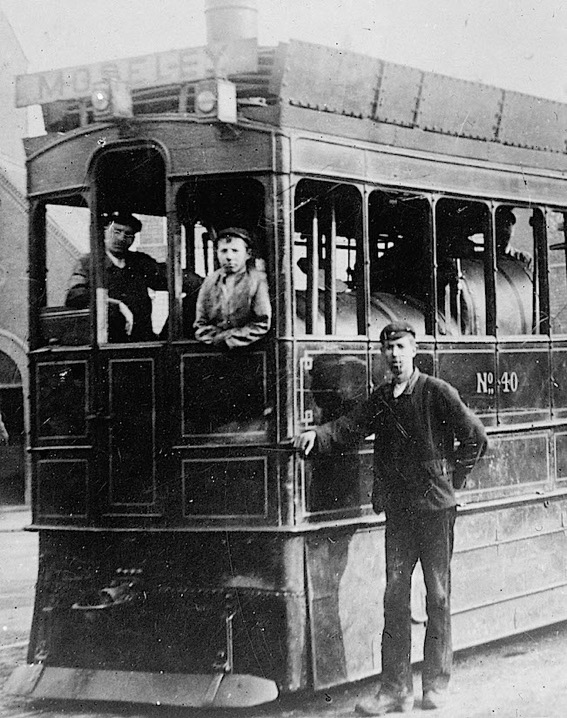
A driver, a stoker and a fitter (probably) pose for the cameraman at Silver Street depot with Falcon Steam Tram No 40 — photo undated, but probably taken in the late 1890s or early 1900s. Photo courtesy of the National Tramway Museum.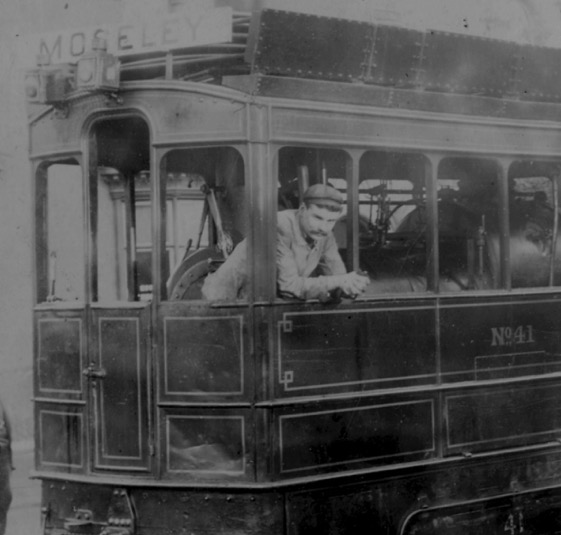
The driver of Falcon Steam Tram No 41 poses for the camera with a service for Moseley — photo undated, but given that No 41 was built in 1885 (for the Birmingham Central Tramways Company) and is looking somewhat battered in this shot, it was probably taken in the late 1890s. Photo courtesy of the Tramways and Light Railway Society, with thanks to David Voice.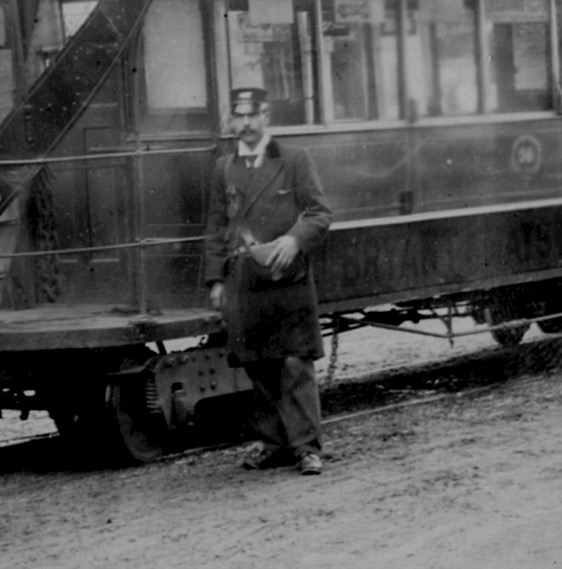
Taken from the same photograph as the previous shot, a conductor poses in front of Steam Trailer No 56, which still bears the device of its former owners, the Birmingham Central Tramways Company, suggesting that the photo was taken not long after 1896. Although the overcoat may not have been a company issue, the drooping-peak cap and cap badge clearly were; the latter was a one-piece, block-capitals, system-initials badge, 'CBT'.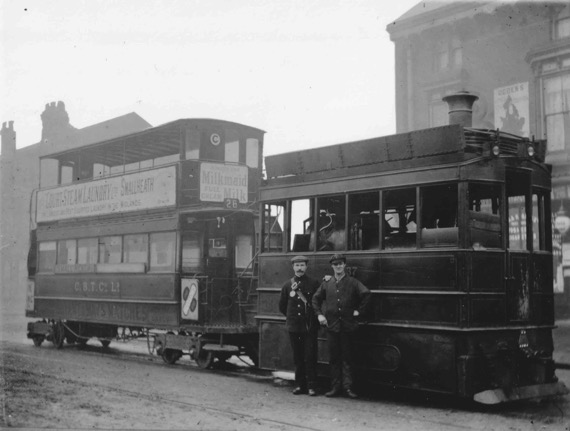
Steam Tram No 37 and Trailer No 26 posed for the cameraman at what is possibly Smallheath — photo dated 1903, i.e., after the takeover of the CofBTCo by the British Electric Traction Company. The steam tram and trailer were both built by Falcon, and were delivered in 1896. 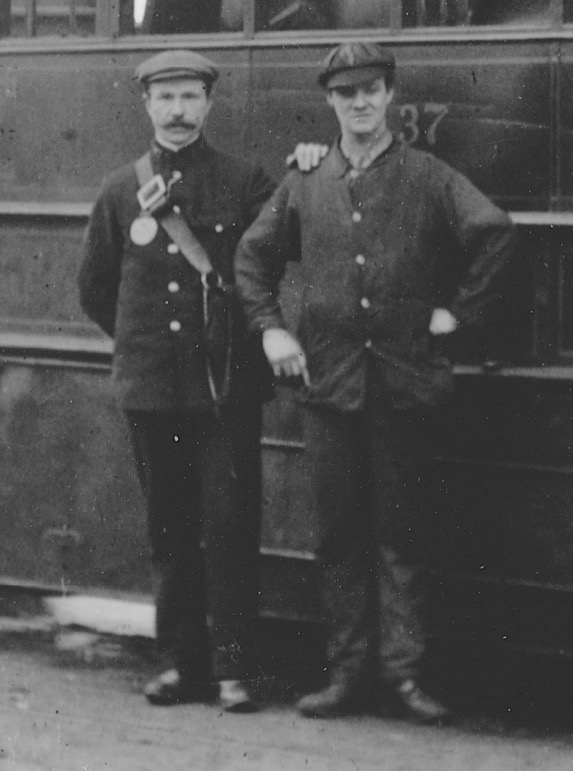
An enlargement of the above photograph showing the conductor (left) and the driver (right). The former is wearing a single-breasted jacket with stand-up collars, along with a flat cap and a round licence badge.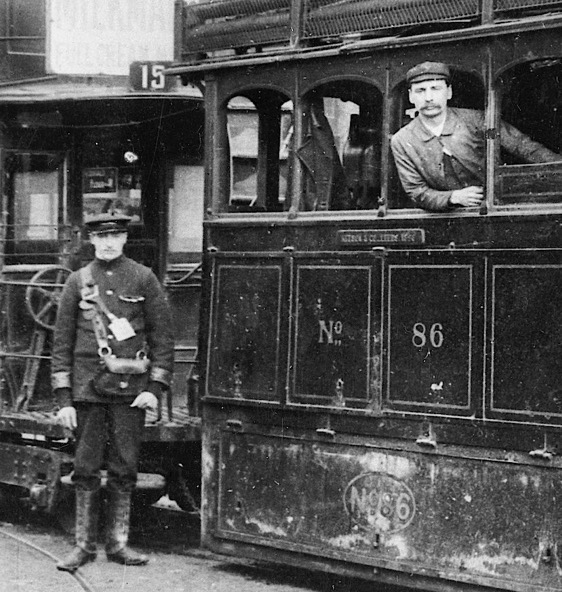
A conductor and a driver on a Saltley service with Kitson Tram No 86 (built 1898) — photo undated, but given that the conductor is wearing a tensioned-crown peaked cap and single-breasted uniform jacket, this may well have been taken in the last days of steam operation (1905/6). Photo courtesy of the National Tramway Museum.
Script-lettering grade cap badge — 'Conductor' — of the type issued to staff working the CofBTCo's steam, cable and electric services, from circa 1902 to 1906. Brass. Author's Collection.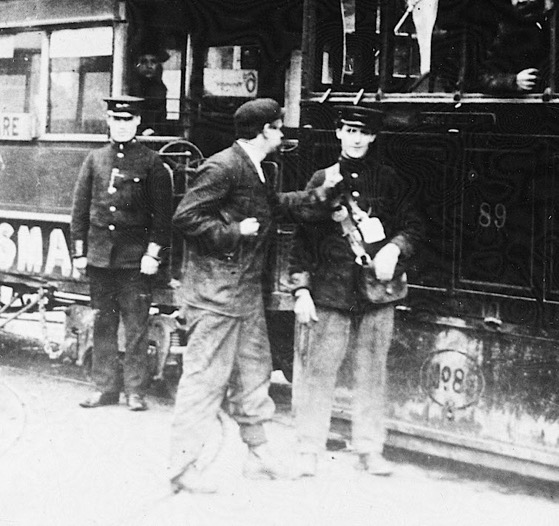
Two conductors and an engine driver with Kitson Steam Tram No 89 on the Saltley route, once again, probably taken in the last years of steam operation under B&MTJC jurisdiction. Photo courtesy of the National Tramway Museum.
Cable tram drivers and conductors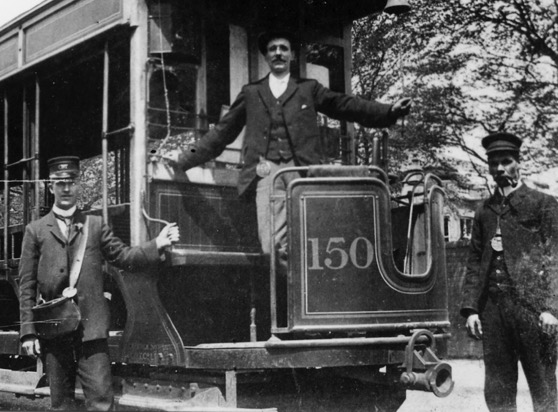
A conductor and two (?) drivers pose for the camera with Cable Tram No 150 in Colmore Row — photo undated, but probably taken in 1900/1901. All the individuals in the photo are wearing municipal licence badges. Photo courtesy of the Tramways and Light Railway Society, with thanks to David Voice.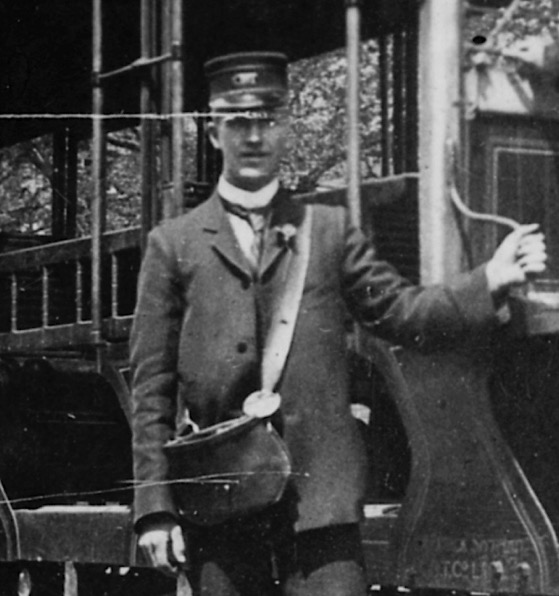
An enlargement of the above photograph showing the conductor; the cap badge appears to comprise the system initials, 'CBT', in block capitals. The subject is clearly wearing an informal jacket.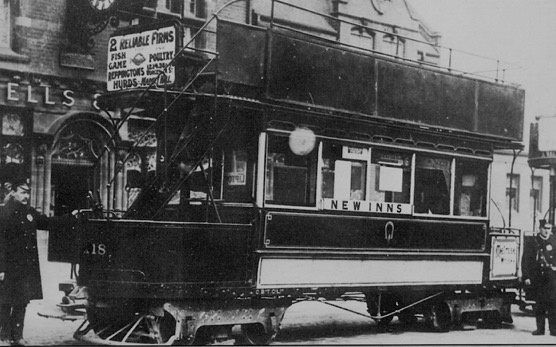
Cable Tram No 118 with conductor and driver — photo undated, but certainly taken after 1904, and probably after 1905, as both men are wearing the large B&MJTC cap badge (see below). Photo courtesy of the Tramways and Light Railway Society, with thanks to David Voice.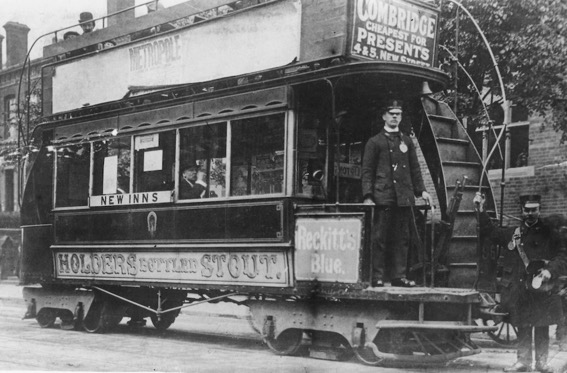
Cable Tram No 96 stands with crew in Holyhead Rd, Handsworth — photo undated, but thought to have been taken around 1909. Author's Collection.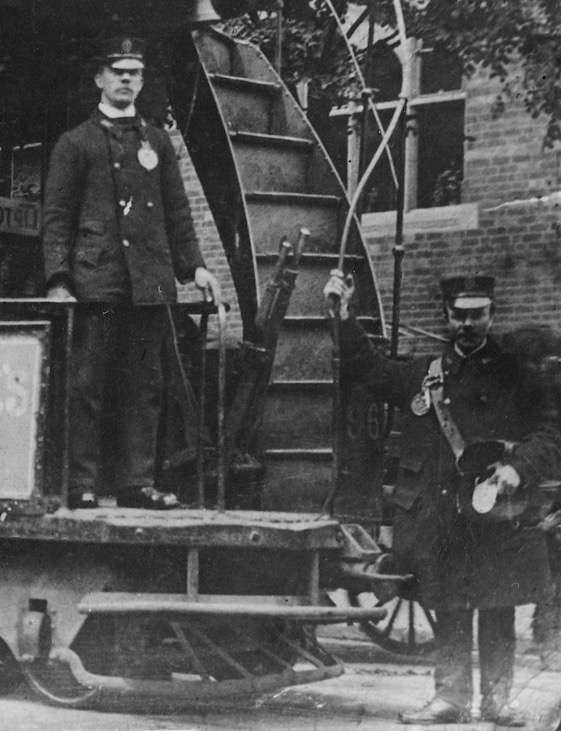
An enlargement of the above photograph showing the driver and the conductor, both of whom are wearing licence badges and drooping-peak caps bearing the standard B&MTJC cap badge (see below).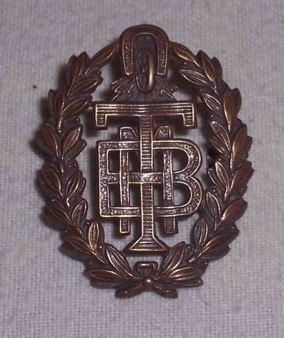
Birmingham and Midland Tramways Joint Committee cap badge — brass. This was introduced after 1904 (probably around 1905/6), when the City of Birmingham Tramways Company was managed by the B&MTJC. Note the use of the British Electric Traction Company 'Magnet and Wheel' symbol; the BETCo controlled the B&MTJC and all its constituent tramway companies, including the CofBTCo.
Motormen and conductors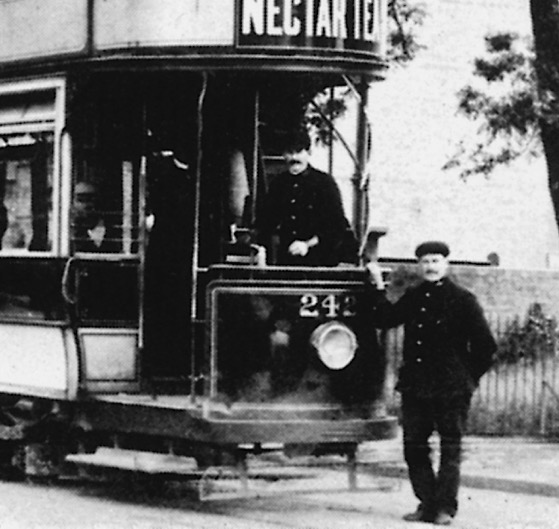
The crew of Tramcar No 242 pose for the camera with a Birmingham-bound service — photo undated, but definitely taken no earlier than 1904, when No 242 was put into service. Both men appear to be wearing flat caps with their uniforms. Photo courtesy of the Tramways and Light Railway Society, with thanks to David Voice.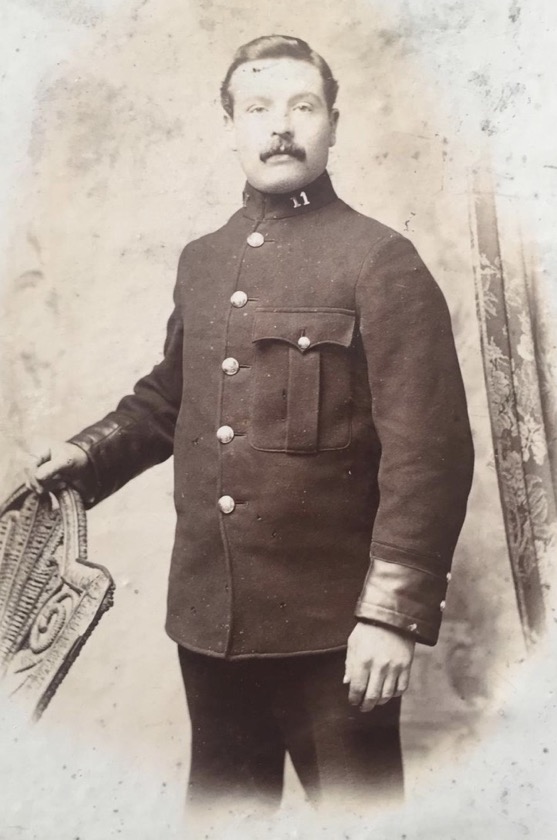
A studio portrait of Edward Davies, who was probably a CofBTCo employee. The photograph was taken in central Birmingham at the studios of Hamnett Photographers on Bristol St; they were only in business at these premises, and with this specific trading name, from 1904 to 1912, so the earliest the image could have been taken is 1904. The buttons are the standard BETCo 'Magnet & Wheel' pattern, so he definitely worked for one of the BETCo systems that were eventually subsumed into the Birmingham & Midland Tramways. The CofBTCo is certainly the best candidate system as it would seem unlikely that Mr Davies would have travelled to central Birmingham to be photographed if he were working on one of the BETCo systems to the north and west of Birmingham in the Black Country. The photo was probably taken in 1905 or 1906, and depicts the uniform worn at this time; he is also not wearing a cap, which tallies nicely with other photos taken at this time, which show tramwaymen wearing flat caps. Mr Davies was living in Dudley in 1901 (working as a stationary engine driver), and by 1911 he was working on the railways and living in Sparkbrook, Birmingham. Photo courtesy of Gillian Flint, with thanks to Amanda Higham.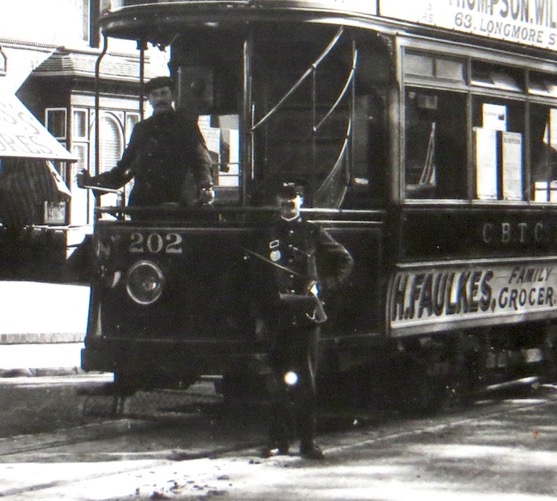
The crew of Tramcar No 202 pose for the camera — photo undated, but definitely taken after 1904, when No 202 was built. The driver is wearing a flat cap, whilst the conductor appears to be wearing a tensioned-crown peaked cap. With thanks to Judith and David Smith.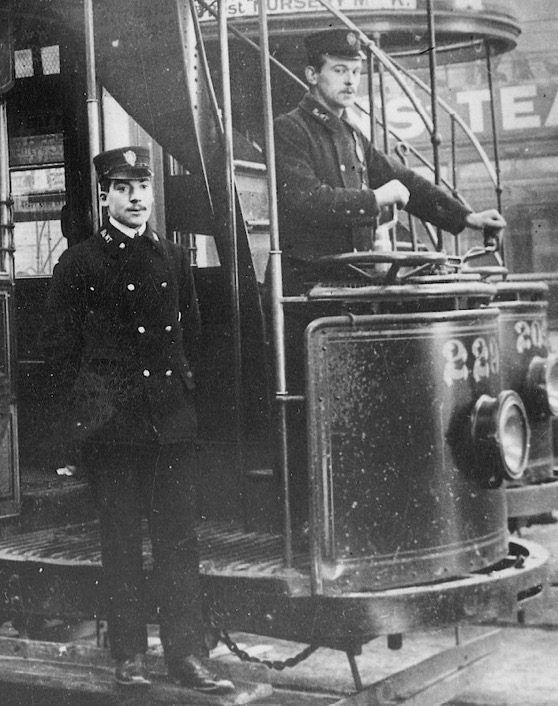
A conductor and a motorman on the platform of Tramcar No 229 — photo undated, but definitely taken during B&MTJC days, and probably around 1906/7. The collar badges are individual system initials: 'B & M T'. Author's Collection.
Probable BB&MTJC early 'rope effect' collar initials and collar number. Author's Collection.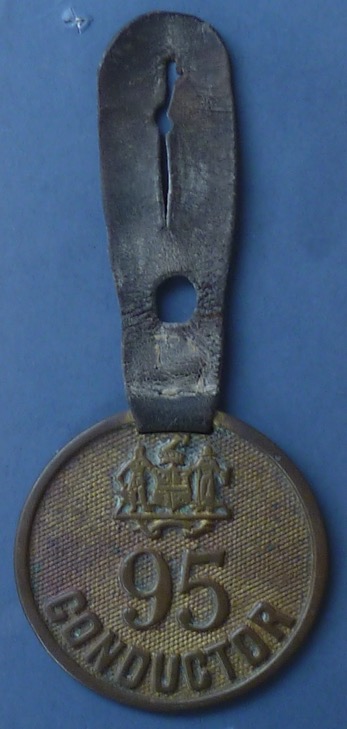
Birmingham municipal ‘CONDUCTOR’ licence badge. This is probably the pattern of licence badge issued to all conductors working electric services within Birmingham — including companies and the corporation — from the early Edwardian era through to the Great War. Author's Collection.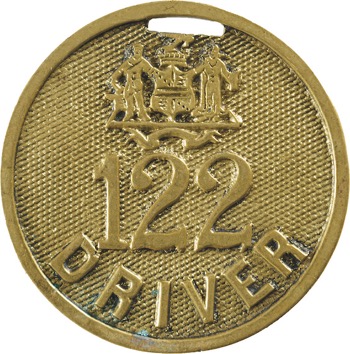
Birmingham municipal ‘DRIVER’ licence badge. This is probably the pattern of licence badge issued to all motormen working electric services within Birmingham — including companies and the corporation — from the early Edwardian era through to the Great War. Author's Collection.
Senior staff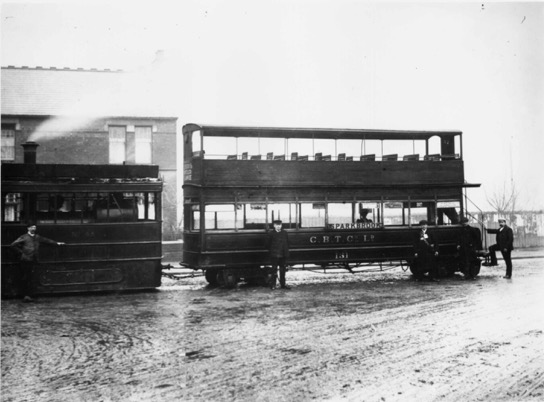
Falcon-built Steam Tram No 45 and CBT-built Trailer No 131 stand at the Springfield terminus in Stratford Road — photo believed to have been taken on the last day of steam operation in Birmingham, namely, the 31st December 1906. Photo courtesy of the Tramways and Light Railway Society, with thanks to David Voice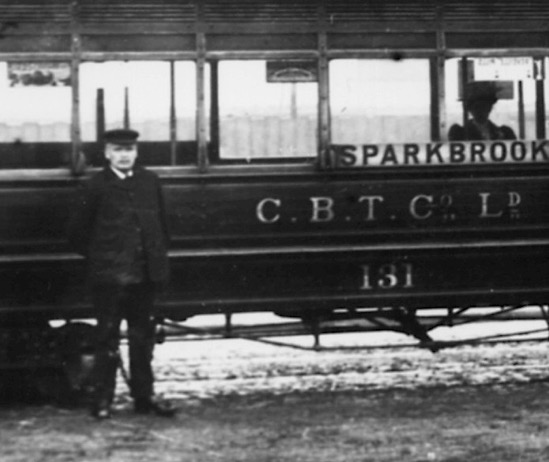
An enlargement of the above photograph showing an individual who is possibly an inspector.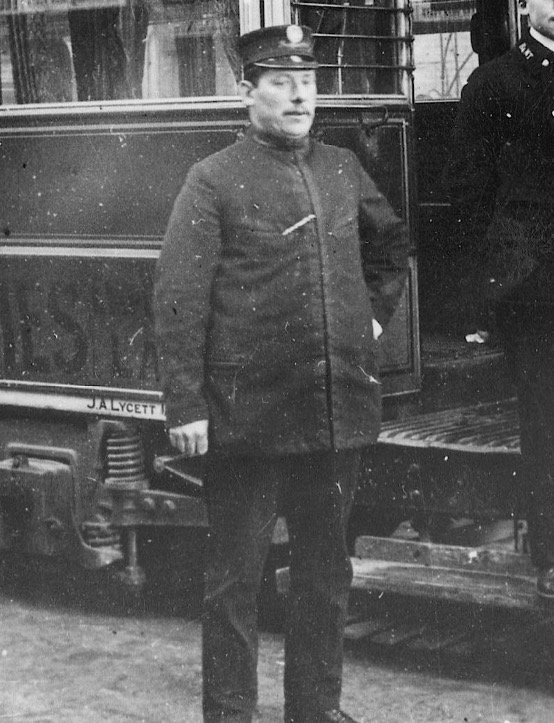
A City of Birmingham Tramways inspector in B&MTJC days (i.e, post 1904/5), taken from the same photograph as that of the crew of No 229 above. Author's Collection.